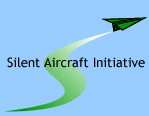Goal: Dramatically Reduce Aircraft Noise
 Listen: Do you hear that sound? No?
That's the point. The Cambridge-MIT Institute (CMI) is launching a
unique project to design a 'silent' aircraft.
Listen: Do you hear that sound? No?
That's the point. The Cambridge-MIT Institute (CMI) is launching a
unique project to design a 'silent' aircraft.
CMI's "Silent Aircraft" project has a bold aim: to discover ways
to reduce aircraft noise dramatically, to the point where it would
be virtually unnoticeable to people outside the airport perimeter
in a typical built-up area.
This initiative is bringing together leading academics from
Cambridge University and the Massachusetts Institute of Technology
(MIT) with representatives from all parts of the civil
aerospace/aviation industry. This unique community will be working
together, sharing knowledge and developing the design for an
aircraft whose noise emissions would barely be heard above the
background noise level in a typical built-up area.
Partners in the project include British Airways, the Civil
Aviation Authority, regional aerospace company Marshall of
Cambridge, and National Air Traffic Services. They also include
Rolls-Royce, which has made available its multi-million pound suite
of design and analysis tools to help the research. Additionally,
the project team plans to include representatives of community
groups opposed to aircraft noise.
Professor Ann Dowling, from Cambridge University's Department of
Engineering, is one of the project's leaders.
"The civil aviation industry is already introducing small,
incremental decreases in aircraft noise", she says. "But we are
aiming for a radical change in noise levels - so that beyond the
perimeter of the airport, the noise of aircraft flying would be
imperceptible to the public."
Both in the United States and Europe, aircraft noise has been
one of the major factors holding back the growth of air transport.
Airports that have tried to expand to increase capacity and ease
delays have met resistance from local groups, worried about the
impact of increased aircraft noise.
The leaders of CMI's 'Silent Aircraft' initiative claim that
designing silent aircraft will help overcome this problem, as well
as providing a major boost to the UK aerospace industry, and
helping UK airlines operate more productively.
Professor Ed Greitzer is the project's leader at MIT. He says,
"Although there have been a number of improvements in aircraft
design, the overall shape of passenger aircraft has in general not
altered a great deal over the last 40 years. A new departure in
this project is to start with the idea of having a major decrease
in noise as a primary design variable. With this, we envisage
consequent major changes in aircraft configuration and operations.
'Silent' aircraft would help meet passenger demand for more
flights, by creating opportunities for new airports, and allowing
increased operations at existing airports."
CMI's 'Silent Aircraft' initiative is one of four new Knowledge
Integration Communities (KICs) that CMI is setting up this autumn.
These KICs aim to find new ways in which academia and industry can
work together and exchange knowledge to push forward research in
areas where UK industry has a demonstrable competitive position -
like aerospace. The Silent Aircraft KIC also aims to enhance this
position by engaging with youngsters of all ages to enthuse them
about aviation, and thus help ensure a continuing supply of
talented individuals into the industry in years to come.
In one knowledge exchange initiative, the students on the
project team studying aircraft engine design will spend a month
seconded to Rolls-Royce at Derby. Staff from Rolls-Royce will then
come back to Cambridge to continue the work. They will be using
some Rolls-Royce design codes as they undertake a fundamental
redesign of the elements of the engine that contribute most to
noise.

"This is a bold project to address what is an increasingly acute
environmental problem for the civil aviation industry in the UK,"
said Dr Nigel Birch, Chief of Noise Engineering at Rolls-Royce.
"Rolls-Royce is undertaking its own research in aircraft engine
noise reduction, but to achieve a very large step change in the
performance of aircraft requires a radical integrated approach to
the design and operation of future aircraft and flight systems.
This was identified by the recent UK Cabinet Office sponsored
Aerospace Innovation and Growth team as key to continuing the
success of the UK aerospace industry. We believe that the breadth
and depth of skills and knowledge available at Cambridge and MIT
will be a valuable contribution to research in this area.
Crucially, CMI has succeeded in engaging in the project all parties
who can actually implement the results of the research in real
projects where the gains can be exploited. We are highly committed
to this project and look forward to its success."
"We welcome continued research into quieter aircraft technology,
and especially the work that aims to optimize operational
procedures within capacity constraints, in the context of improving
UK competitiveness. Minimizing noise from flight operations is a
priority for British Airways, and we look forward to the
contribution the project can make towards this goal," Andy Kershaw,
Manager of Environmental Affairs for British Airways.
"Environmental factors play an increasingly important part in
modern airport operations and noise is a key issue," Iain Young,
Chief Test Pilot of Marshall of Cambridge. "A reduction in aircraft
noise would make a significant contribution to the development of
regional airports through reducing the noise impact on local
communities. We are delighted to support this initiative and look
forward to participating in an important and interesting
program."
(ANN Correspondent Matthew French, based in Turku, Finland,
contributed to this story)
 ANN's Daily Aero-Term (04.14.24): Maximum Authorized Altitude
ANN's Daily Aero-Term (04.14.24): Maximum Authorized Altitude ANN's Daily Aero-Linx (04.14.24)
ANN's Daily Aero-Linx (04.14.24) Classic Aero-TV: 'We're Surviving'-- Kyle Franklin Describes Airshow Life 2013
Classic Aero-TV: 'We're Surviving'-- Kyle Franklin Describes Airshow Life 2013 Aero-News: Quote of the Day (04.14.24)
Aero-News: Quote of the Day (04.14.24) Airborne 04.09.24: SnF24!, Piper-DeltaHawk!, Fisher Update, Junkers
Airborne 04.09.24: SnF24!, Piper-DeltaHawk!, Fisher Update, Junkers




